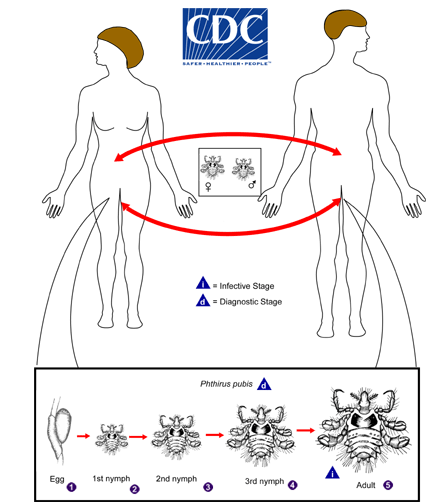Biology
Causal Agent:
Phthirus pubis, the pubic or crab louse, is an insect of the order Psocodea and is an ectoparasite whose only host are humans.
Life Cycle:

Pubic lice (Phthirus pubis) have three stages: egg, nymph and adult. Eggs (nits) are laid on a hair shaft ![]() . Females will lay approximately 30 eggs during their 3–4 week life span. Eggs hatch after about a week and become nymphs, which look like smaller versions of the adults. The nymphs undergo three molts (
. Females will lay approximately 30 eggs during their 3–4 week life span. Eggs hatch after about a week and become nymphs, which look like smaller versions of the adults. The nymphs undergo three molts (![]() ,
, ![]() ,
, ![]() ) before becoming adults
) before becoming adults ![]() . Adults are 1.5–2.0 mm long and flattened. They are much broader in comparison to head and body lice. Adults are found only on the human host and require human blood to survive. If adults are forced off the host, they will die within 24–48 hours without a blood feeding. Pubic lice are transmitted from person to person most-commonly via sexual contact, although fomites (bedding, clothing) may play a minor role in their transmission.
. Adults are 1.5–2.0 mm long and flattened. They are much broader in comparison to head and body lice. Adults are found only on the human host and require human blood to survive. If adults are forced off the host, they will die within 24–48 hours without a blood feeding. Pubic lice are transmitted from person to person most-commonly via sexual contact, although fomites (bedding, clothing) may play a minor role in their transmission.
Life cycle image and information courtesy of DPDx.
- Page last reviewed: March 17, 2015
- Page last updated: March 17, 2015
- Content source:


 ShareCompartir
ShareCompartir